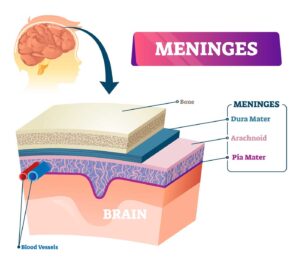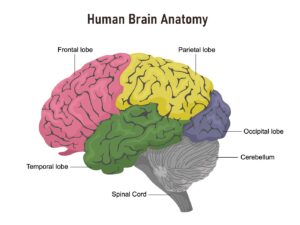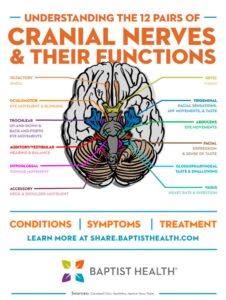Brain Health & Memory, Part 2: Brain Anatomy

Written by: Dr. Claire Arcidiacono, ND
For further questions or concerns email me at [email protected]†
In our last blog we started talking about the anatomy of the brain. Today we will continue this topic and even expand into some structures that are important to our overall brain health. To begin with today we will talk about a structure that is found surrounding the brain, this is a covering called the meninges. I won’t get into too much detail regarding this, but it is made up of 3 layers. These are the Dura, Arachnoid and the Pia. It is in these layers that the brain’s veins, arteries and even cerebrospinal fluid are found. Please see the attached picture. † (1)

Back to the cerebrum, it is surrounded by the cerebral cortex which is broken down into the different lobes that you may have heard of. These include the frontal lobe, the parietal lobe, the temporal lobe and the occipital lobe. Please see the attached picture. † (1)

The frontal lobe is considered to be the “action cortex” and is in charge of different types of motion. For example, this includes skeletal movement as well as ocular movements. Speech, expression of emotions as well as many mental actions are controlled by this lobe. (2) The next lobe the parietal lobe is very important in dealing with language. It also helps with handing sensory information and is in control of our knowledge of numbers. (3) The occipital lobe is critical when it comes to vision. (4) Lastly the temporal lobe helps with things such as visual memory, language skills, short term memory, and musical rhythm and even smell recognition as well as regulating our emotions. (5) It will be important to understand the different lobes and their functions later on when we get into more condition specific blogs. For example, TIAs and strokes are common causes of frontal lobe damage. They lead to symptoms such as inappropriate emotional responses whereas damage to the occipital lobe leads to vision problems. (1) As I said in my prior blog the cerebrum is split into 2 hemispheres connected together. What is interesting about this is that each hemisphere controls the opposite side of the body. † (5)
The brain also contains other structures that are important to regulating different bodily functions. These include the pituitary gland, the hypothalamus, the amygdala, the hippocampus and the pineal gland. Each of these structures have important functions. The pituitary gland is in charge of other glands such as the thyroid, the adrenals, ovaries and the testicles. The pituitary is in turn controlled by the hypothalamus. In addition to controlling the pituitary the hypothalamus also helps to regulate body temperature, sleep patterns, memory, emotions as well as hunger and thirst. The next structure the amygdala is associated with fight or flight as well as our general emotion/memory and regulating what is called the “brains reward system”. The hippocampus supports our memory, learning and perception of space. Lastly the pineal gland regulates our circadian rhythms. † (1)
ICYMI:INTRODUCTION TO BRAIN HEALTH & MEMORY, INVITE HEALTH BLOG>>READ NOW
Supporting the brain is the brain’s blood supply of the vertebral arteries and the carotid arteries. There are also the basilar artery and the circle of Willis. In addition to this blood supply there is a watery fluid known as cerebrospinal fluid which helps to remove waste and deliver nutrients to the brain. (1, 7) Now I would like to take the time to mention something you might have heard about – the blood brain barrier (BBB). Simply put the BBB helps to restrict exactly what is permitted to cross into the cerebrospinal fluid and pass into the brain itself. † (8)
Lastly inside the cranium (the top of the skull) are the 12 cranial nerves. Each of these 12 nerves regulates different functions of the body. Please see the attached picture for more detailed information on each of these nerves. † (9)

The human brain is a complex topic that even to this day is not completely understood. The goal of this overview was not to turn us into neurosurgeons but instead make sure when we get into more condition- specific blogs, we know enough to understand the basic structures that are involved in brain health. In this series we will explore how to keep our brain healthy and we will also concentrate on how keeping our brain healthy will help with our memory. Since memory is one of the things, I get asked most about it will be a huge focus of this series. †
Since changes in memory and brain health can be brought about by many different underlying conditions next week, I will be discussing what blood work/ tests you should talk to your doctor about. †
ICYMI: KEEPING THE BRAIN CLEAN WITH RESVERATROL, INVITE HEALTH PODCAST, EPISODE 645>>LISTEN NOW
REFERENCES
- https://www.hopkinsmedicine.org/health/conditions-and-diseases/anatomy-of-the-brain
- Kimberg DY, Farah MJ (December 1993). “A unified account of cognitive impairments following frontal lobe damage: the role of working memory in complex, organized behavior”. Journal of Experimental Psychology. General. 122 (4): 411–28. doi:1037/0096-3445.122.4.411. PMID 8263463.
- Baldauf D, Cui H, Andersen RA (October 2008). “The posterior parietal cortex encodes in parallel both goals for double-reach sequences”. The Journal of Neuroscience. 28 (40): 10081–9. doi:1523/JNEUROSCI.3423-08.2008. PMC 2744218. PMID 18829966.
- “SparkNotes: Brain Anatomy: Parietal and Occipital Lobes”. Archived from the original on 31 December 2007. Retrieved 27 February 2008.
- Smith; Kosslyn (2007). Cognitive Psychology: Mind and Brain. New Jersey: Prentice Hall. pp. 21, 194–199, 349.
- Rosdahl, Caroline; Kowalski, Mary (2008). Textbook of Basic Nursing (9th ed.). Lippincott Williams & Wilkins. p. 189. ISBN 9780781765213. Retrieved 28 January 2015.
- https://medlineplus.gov/lab-tests/cerebrospinal-fluid-csf-analysis/
- Daneman R, Prat A (January 2015). “The blood-brain barrier”. Cold Spring Harbor Perspectives in Biology. 7 (1): a020412. doi:1101/cshperspect.a020412. PMC 4292164. PMID 25561720.
- https://www.baptisthealth.com/blog/health-and-wellness/understanding-cranial-nerves-and-their-functions


